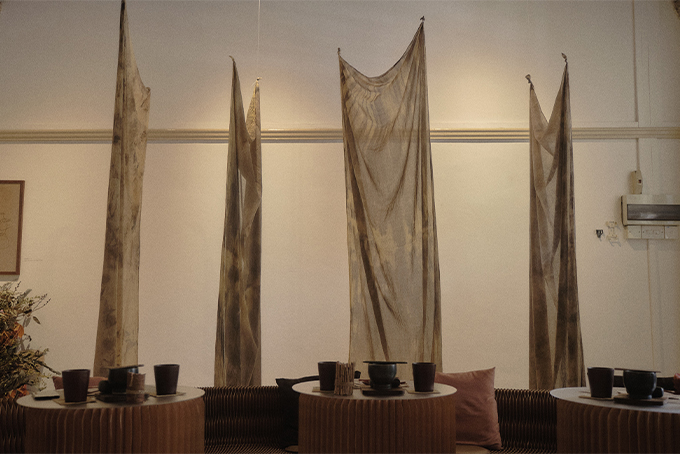Natural dyeing—the practice of extracting pigments from plants, bugs and other things of the earth to colour cloth—is a difficult art. Its materials are notoriously unruly, requiring formulas so precise they approach science: a hair difference in weight shifts the colour; a slight change in acidity flubs the texture—the dye bath is a well of rebellion. But to Crystal Lee, 30, artist and self-dubbed soul behind Project Coal, ceding control to nature is a matter of course. She takes care not to call the craft difficult, preferring instead to praise the “alchemy” of the process (though she is just as careful to warn clients of unexpected results). “At the start, it made me feel closer to nature,” she muses, “now I am drawn to the intrigue of the colour changes; how drops of vinegar or lemon juice can change one colour into something else.”

Since 2014, Project Coal has been quietly turning out dappled garments and tapestries, stained with foraged materials. Lee’s debut products were silk scarves treated with logwood, turmeric, madder and tea. These days, her garment work is mostly commissioned, clients entrust her with old clothes to be made over with custom dyes. Her armoury is spellbinding. She recites a list of folkloric materials: cutch, rust, gall nuts, the bark of the Gum Arabic tree. The process is romantically long: scouring, mordanting, colour-matching and resolving to make something special are discrete undertakings that precede the actual dyeing. Dyeing then involves creating stains, fiddling with textures, and layering them until the vision is complete. In between is a lot of waiting. Often the vision is gothic, earthy, gently evocative of its visceral ingredients. Her Furoshiki 05 (Japanese traditional wrapping cloth) comes in a deep russet, with splotches of pale brown, the colour of dead leaves. 07’s chalky brown with black patches looks like trampled earth.

Her gritty, marled designs have a certain cachet, even among creatives. Lee was the first artist to be showcased at Alter Native, the exclusive private dining and exhibition salon helmed by culinary enfant terrible, Desmond Chen. In Chen’s historic Mcnair road home, Lee’s gauzy tapestries hung from gossamer threads. Nostalgically mottled, they sagged and fluttered with the wind; I thought of the coy weight of light things.
“People look at my natural dye and think I am in fashion but I am not a fashion designer, I am an artist who works with textiles.”
Dyed runners lined an adjacent wall, their pale sheets blooming with blots and streaks of ink, some like the footprints of birds. Chen called Lee’s work “emotive,” crediting the conception of his 15-course menu to the subtle feelings stirred by her objects. (The vivid fuchsia of his dragon fruit, sorrel and mint raita was inspired by Lee’s exacting manipulation of pH levels to achieve her desired hues.) And she is beginning to flirt with metaphor; at Aa Furniture’s February market, she collaborated with a botanical landscapist on an abstract fabric-floral display. A curtain of white cotton was dipped in a bath of iron water, ringed by an arrangement of plants. Over three days, the dye water seeped into the cloth, slowly blackening it.

Of her distinct aesthetic — local dye works tend more lurid — Lee is coolly ambivalent. When I ask what inspires her, she gives the cliched question serious thought before answering: “Everything. All my experiences.” She is trained in fine art, which explains her considered process, one that begins with the shrewdness of an artist: “I ask myself how I want [the work] to make people feel. People look at my natural dye and think I am in fashion but I am not a fashion designer, I am an artist who works with textiles.” She also has a documentarian’s interest in South East Asia’s ancient, indigenous arts, collecting pictures and devouring tomes on niche cultures. We pause briefly for excited digressions on Balinese ceremonies and her time at an Indian ashram.

Of course, natural dyeing is a timeworn craft. Its history reaches back to Ancient Rome, when Nero famously declared ownership of Tyrian purple, the sumptuous violet rendered from the mucus of the Murex snail. At its best, it is the rich, grim shade of clotted blood. Project Coal’s own history began in 2013, in a garden beside the woods of Kent, England where Lee stayed with her then-boyfriend.
“At the start, it made me feel closer to nature, now I am drawn to the intrigue of the colour changes.”
She had been gifted a beginner’s book on natural dyeing and, restless in the English countryside, had wandered into the forest, returning with armfuls of fruits and bits of undergrowth. Nowadays, her forays happen in the shower of her home. Its tiled floor is stacked with pots, its thin piping stuffed with stirring paddles — no small feat since archaeologists have tended to find ancient dyeworks relegated to the outskirts of towns. Lee is similarly blasé about the sacrifice. “I knew what I needed,” she says, laughing.

It may not be the woodlands of Kent, but Singapore has its draws. Lee’s tapestries flapped and flew at a rave in March, hosted by longtime friends and music collective Strange Weather All Day. Dancers weaved between her canvases and interpreted them freely, wrapping or draping their bodies at whim. For the first time, her work was art installation, set and costume in one — precisely the way she’s always seen it.
Order your copy of the April ‘Pop’ issue of Vogue Singapore online or pick it up on newsstands on 13 April 2023.





